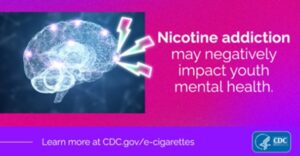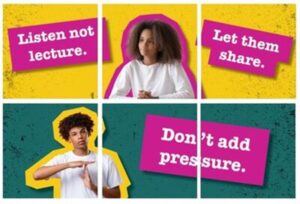This post aims to educate parents, caregivers, and others about vaping (e-cigarettes). The emphasis is around youth use. Why? Over 3 million middle and high students use tobacco. E-cigarettes are the most popular product among them.1
Source: UNDO (Flavored Tobacco | Hiding in Plain Sight (can you spot this teen’s vapes?) – YouTube)
Tobacco Use Among Alaskan High School Students2
- About 35% of Alaskan high school students currently use any kind of tobacco
- E-cigarettes are the most popular product, with 26% saying they currently used them in 2019. E-cigarette use increased from 18% in 2015.
- Smokeless tobacco was the second most used tobacco product. About 11% said they used it. Cigarettes came in at third, with 8% saying they use them.
- 46% said they tried e-cigarettes at some point in time. That’s compared to 28% saying they tried cigarettes.
- Among high school smokers, 7% said they started before they turned 13.
What Are Vape/E-Cigarettes3,4
E-cigarettes are battery-powered devices that work by heating a liquid into an aerosol that the user inhales and exhales. They come in a variety of shapes and sizes (see the graphic above). Some are reusable while others are disposable. They are known by a variety of names, such as vapes, vaporizers, vape pens, dab pens, pods, . Dab pens are usually used for marijuana.
Why Is Vaping So Popular?1,5
- Appealing flavors. Almost 85% use flavored e-cigarettes. Fruit is the most popular, followed by candy, desserts, and sweets.
- 76% of students reported exposure to tobacco marketing through traditional media, like newspapers and magazines. About 74% who used social media have seen e-cigarette related posts or content.
- Peer Use and Curiosity were commonly cited when asked why they first tried e-cigarettes.
- Feelings of Anxiety, Stress, or Depression were the most cited reasons for continued use of e-cigarettes. Symptoms of anxiety and depression are common during nicotine withdrawal. Use of nicotine-containing products can temporarily relief these symptoms, which can lead to continued nicotine use.


Source: Centers for Disease Control and Prevention
Concerns Around Vaping6,7,8
E-cigarettes can look like common non-drug related objects, like flashdrives. This can make them easy to hide. Popular brands among high school students include: Puff Bar, Vuse, Smok, Juul, and Suorin.
A recent Johns Hopkins study found almost 2,000 chemicals in e-cigarettes. We still don’t know all the impacts of breathing in these chemicals. We do know the impacts of some due to them being found in cigarettes and other products. Examples of these chemicals include:
- Propylene glycol
- Carcinogens
- Acrolein
- Diacetyl
- Diethylene glycol
- Heavy metals
- Cadmium
- Benzene
- Ultrafine particles
- Flavorings (some flavors may be okay to ingest but are not safe to inhale. If inhaled, they can harm lungs)
These chemicals are known to:
- Cause cancer
- Damage organs
- Cause lung and heart disease
There have also been reports of e-cigarettes exploding. This can result in burns. Check out FEMA’s flyer on e-cigarettes and fire safety.
Nicotine and the Brain9,10,11
A person’s brain does not fully develop until the mid- to late 20s. The prefrontal cortex (responsible for planning, prioritizing, and controlling impulses) is one of the last areas to fully mature. This means that teens are more likely to engage in risky behaviors without considering the potential results of their decisions.
E-cigarettes contains nicotine. Nicotine can be particularly risky for teens due to their brains are still developing in that:
- Younger initiation increases the risk of addiction. About 90% of adult daily smokers first tried smoking before they turned 18.
- Nicotine has been linked to mood disorders
- Nicotine can permanently lower impulse control
- Nicotine also changes how the synapses form. This can negatively impact learning and attention.
- This wouldn’t just impact school performance. If your child participates in sports or band, they may have a hard time learning new play/formations or songs.


Source: Massachusetts Tobacco Cessation and Prevention Program
Talk About Vaping12
Check out TalkAboutVaping.Org for a more detailed conversation guide as well as other facts about vaping. The guide was developed in conjunction with child psychologists. General tips from it include:
- Know the facts
- Put yourself in your child’s shoes
- Take an open and calm approach
- Find the right time and place
- Practice before talking with them
- Acknowledge your child’s independence
- Ask for their perspective
- Be ready to hear that your child may have or is vaping
- Blame Big Tobacco, not your kid
- Avoid scare tactics
- Connect with what they care about
- Thank them for talking and listening
- Help them manage stress and peer pressure
- Follow up
- Stay up to date
My Kid Vapes or Uses Another Tobacco Product
Talk with them about vaping/tobacco and its impacts using the tips from above. If they want to quit, resources are available specifically for young people. They include:
- Live Vape Free: teens can text VAPEFREE 873373 as well. This is from the State of Alaska Tobacco Prevention and Control Program
- Not For Me: online program developed by the American Lung Association
- Smokefree Teen: teens can text QUIT to 47848 or download the quitSTART app. This is from the National Cancer Institute
- Check out some tips for supporting someone in their quit journey
Gentle reminder, that the decision to quit is on them. They will get help when they’re ready.
Other Resources
- FDA’S How Vapes Work
- FEMA’S E-Cigarettes and Fire Safety
- UNDO’s E-Cigarettes and Environmental Impacts
- Truth Initiative’s E-Cigarettes and Environmental Impacts
- CDC General Information on E-Cigarettes
References
- Results from the Annual National Youth Tobacco Survey | FDA
- FY20 Alaska Statewide Regional Profiles Tobacco Report
- About Electronic Cigarettes (E-Cigarettes) | Smoking and Tobacco Use | CDC
- E-Cigarette, or Vaping, Products Visual Dictionary (cdc.gov)
- Approximately 2.55 Million Students Reported Currently Using a Tobacco Product in 2021 | CDC Online Newsroom | CDC
- Nearly 2,000 Chemicals—Some Potentially Harmful—Found in Vaping Aerosols | Smart News| Smithsonian Magazine
- What’s in an E-Cigarette? | American Lung Association
- pdf (tobaccofreekids.org)
- NIMH » The Teen Brain: 7 Things to Know (nih.gov)
- Smoking Initiation Shifting from Teens to Young Adults – NCI (cancer.gov)
- Know the Risks of E-cigarettes for Young People | Know the Risks: E-cigarettes & Young People | U.S. Surgeon General’s Report
- Talk To Your Child About Vaping | American Lung Association



